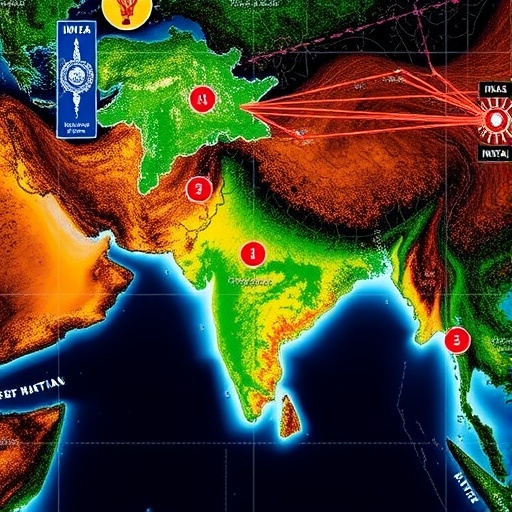Using a groundbreaking dataset that encompasses over 415 million buildings across 50 sub-Saharan African nations, researchers at the University of Chicago have developed a novel framework for urban development that scrutinizes infrastructure accessibility at an unprecedented level. This influential study, recently published in the distinguished journal Nature, analyzes the infrastructure gaps in rapidly developing countries, focusing particularly on how these gaps affect critical public services for their residents. By leveraging high-resolution data, the researchers successfully map street access to every building, illuminating the impact of connectivity on essential services such as water, sanitation, education, and economic opportunities.
Dr. Luis Bettencourt, a professor of Ecology and Evolution at UChicago and the principal investigator of this study, pointed out a universal truth observable in developed cities: each building has reliable access to streets. This is critical for delivering fundamental services like water and sanitation while enabling safety measures and efficient administration. Bettencourt emphasized that this connectivity is not just about physical access; it fosters a sense of security and community for the urban populace. However, as urbanization accelerates in many parts of the world, particularly in informal settlements, the challenge lies in providing that access to these burgeoning populations.
The researchers recognize that many rapidly growing cities aren’t equipped with the infrastructure necessary to address the needs of every resident, especially in slum areas. These infrastructural deficits lead to a host of socioeconomic issues, limiting the potential for individual and collective development. Bettencourt’s research demonstrates that by employing a systematic approach to measure accessibility, targeted interventions can be designed to alleviate the deficiencies experienced by specific households or blocks throughout the urban landscape.
Localization is a vital strategy highlighted by the researchers, advocating for development initiatives that operate at the neighborhood level. This localized approach becomes significant due to the sheer scale of the problem, which the United Nations estimates at 1.12 billion people living in informal settlements without adequate services. In 2015, poverty reduction and slum eradication became integral components of the United Nations’ Sustainable Development Goals, a broad framework aimed at fostering advancements in health, education, and economic equity.
The methodological framework developed by Bettencourt and his colleague, Nicholas Marchio, takes advantage of a comprehensive dataset crafted by the digital mapping firm Ecopia. They effectively integrated information from OpenStreetMap regarding street networks and demographic data from various reputable sources to create the Million Neighborhoods Africa map. This interactive tool provides an in-depth view of individual urban blocks, enabling stakeholders to assess infrastructure access for every building as well as corresponding population statistics.
A crucial metric introduced in the research is termed “k complexity,” which quantifies the challenge associated with accessing streets from buildings within a block. A lower k value indicates better street access, while higher values expose blocks that are convoluted and remote. The average k complexity across sub-Saharan Africa is reported to be eight – a stark contrast to formal blocks that would typically have values closer to one or two. This detail is notable for urban planners seeking to enhance accessibility in these areas.
Furthermore, the researchers connected block complexity with various human development indicators, conducting comparative analyses across 67 different social and economic dimensions, including education, health, and housing quality. The findings indicate a clear correlation whereby neighborhoods exhibiting higher complexity levels experience a decline in the well-being of their residents, underlining an urgent need for infrastructure improvements.
The study reveals not only clear gaps in access to services in sprawling informal settlements but also identifies smaller enclaves of high complexity within relatively developed urban areas. Addressing infrastructural challenges in these pockets may yield significant benefits, both by fulfilling basic needs and integrating these communities into the broader social and economic tapestry of the city.
Urban science emerges as a powerful lens through which these complex development challenges can be viewed and addressed. By utilizing advanced urban analytics and innovative datasets, the research offers a pathway to accelerate sustainable urban development. Bettencourt asserts that this work holds potential lessons for cities globally, emphasizing the importance of learning from urban experiences and facilitating conditions for effective local solutions that honor the unique characteristics of each community.
Ultimately, the study titled “Infrastructure deficits and informal settlements in sub-Saharan Africa” underscores the relevance of sophisticated data analysis in urban planning. It reconceptualizes strategies for community development and serves as a pivotal reference point for future research endeavors in urban science. This groundbreaking work, supported by esteemed institutions such as the Mansueto Institute for Urban Innovation, is a clarion call for collaboration across sectors to redefine urban living conditions in the face of rapid change and development.
As urban populations continue to surge, the challenge of providing equitable infrastructure access becomes ever more paramount. This research not only lays the groundwork for ongoing studies in urban engineering and policy but also offers a compelling vision for how cities can evolve into inclusive environments where all residents have the opportunity to thrive.
Subject of Research: Infrastructure deficits and informal settlements in sub-Saharan Africa
Article Title: Infrastructure deficits and informal settlements in sub-Saharan Africa
News Publication Date: 3-Sep-2025
Web References: https://sdgs.un.org/goals/goal11, https://sdgs.un.org/goals
References: Bettencourt, Luis; Marchio, Nicholas (2025). “Infrastructure deficits and informal settlements in sub-Saharan Africa”. Nature. DOI: 10.1038/s41586-025-09465-2
Image Credits: Luis Bettencourt
Keywords
Urban development, infrastructure, sub-Saharan Africa, informal settlements, urban science, accessibility, social equity, sustainable development.




